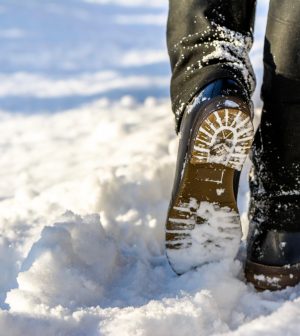- Skip Storing This Everyday Product in the Fridge Door
- Green Tea + B3 Pairing May Boost Brain Health
- Navigating Your Midlife Crisis: Embracing New Possibilities
- City Raccoons Showing Signs of Domestication
- Mapping the Exposome: Science Broadens Focus to Environmental Disease Triggers
- One Week Less on Social Media Linked to Better Mental Health
- Your Brain Changes in Stages as You Age, Study Finds
- Some Suicide Victims Show No Typical Warning Signs, Study Finds
- ByHeart Formula Faces Lawsuits After Babies Sickened With Botulism
- Switch to Vegan Diet Could Cut Your Greenhouse Gas Emissions in Half
Wintertime Wandering: A Real Danger for People With Alzheimer’s

Winter weather can add a layer of danger to the wandering behavior common in people with dementia.
The Alzheimer’s Foundation of America (AFA) offers some suggestions to help prevent wandering and prepare folks to react quickly if it occurs.
“During the winter, it’s especially important for families living in areas affected by cold weather, snow and ice,” said Jennifer Reeder, director of educational and social services for the foundation.
“Being proactive by understanding and addressing the reasons someone may wander, while also having a plan in place in case of an emergency, are the best ways to protect the person’s safety and quality of life,” she said in an AFA news release.
Start by figuring out what motivates your loved one with dementia to wander outdoors.
It may be that it gives the person a feeling of purposefulness, excitement or pleasure. It could also be triggered by too much stimuli and the desire to get away from noises and people. It may also signal an unmet need, such as hunger, thirst or the need to use the bathroom.
You may be able to fill any of these needs more safely and reduce risky wandering, Reeder said.
Try creating walking paths around the home with visual cues and stimulating objects. Engage the person with dementia in simple tasks. Offer stimulating and enjoyable activities, such as exercise, music or crafts. And, of course, ensure basic needs are met.
Make sure the home is safe. Start by keeping walkways free of clutter and tripping hazards. Be mindful about how having certain objects in view, such as car keys, jackets and purses, might trigger the person to leave suddenly.
Install electronic chimes or doorbells on doors. That will alert you if the individual tries to exit. Consider using a smart doorbell with an app that can notify you when someone is entering or exiting the home.
Notice what times of day make your loved one more active and try to provide stimulating activities during that time. Encourage healthy sleep habits to reduce the chances of the person leaving during the middle of the night.
Keep a record of wandering patterns — frequency, duration, time of day — to help guide you in the future.
Have a safety plan. This could include a list of places a person might go, such as their previous home or place of employment. Be sure you have a recent close-up photo of your loved one and accessible medical information for first responders.
Keep a list of folks to contact if the person goes missing. Ask neighbors to call you if they see the person out on their own.
Look into community safety programs, such as Project Lifesaver, which can provide locating technology. First responders can activate this if your loved one is missing. If possible, get input from the person with dementia when developing the plan.
If you need more advice, reach out to a social worker at AFA’s helpline. It’s available by phone at 866-232-8484; text at 646-586-5283, and web chat at www.alzfdn.org.
More information
The U.S. National Institute on Aging has tips on home safety.
SOURCE: Alzheimer’s Foundation of America, news release, Jan. 26, 2023
Source: HealthDay
Copyright © 2025 HealthDay. All rights reserved.










